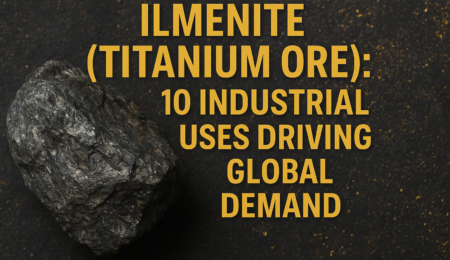For decades, the global spotlight on Nigeria has primarily shone on one resource: oil. But the narrative is changing, rapidly and dramatically. A new giant is awakening, poised to redefine Nigeria’s economic landscape and capture significant international attention. We’re talking about the Nigeria mining industry – a sector bursting with untapped potential, valued at an astonishing $700 billion, and set to become a cornerstone of national prosperity.
This isn’t just a whisper of opportunity; it’s a roaring declaration. As an expert deeply entrenched in this evolving sector, I can confidently tell you: the time to look beyond traditional avenues and embrace Nigeria’s solid minerals wealth is now.
A Nation Blessed: The Untapped Wealth Beneath Our Feet
Nigeria is uniquely endowed with a staggering array of over 44 solid mineral types scattered across its vast landscape. From precious metals and industrial minerals to the critical resources driving the global energy transition, our subsoil is a veritable treasure ocean.
Consider some of the key players:
- Precious Metals: Gold (found in Zamfara, Kaduna, Osun, Niger, etc.), with initiatives like the Kano Gold Souk Trading Centre enhancing its value chain.
- High-Value Gemstones: As we explored previously, Nigeria is a haven for exquisite Tourmaline (including the coveted Paraiba), Sapphire, Aquamarine, Emerald, Garnet, and many more, with significant deposits in states like Nasarawa, Oyo, and Kaduna.
- Critical Minerals: The demand for minerals essential for electric vehicles (EVs) and renewable energy is surging. Nigeria holds substantial reserves of Lithium (Nasarawa, Kwara, Oyo) and Rare Earth Elements, positioning us to become a key player in the global battery industry supply chain.
- Industrial Minerals: Vast deposits of Limestone (over 10.6 billion tonnes, used in cement production), Bitumen (42 billion tonnes, almost twice crude oil reserves, yet largely unexploited), Iron Ore (3 billion tonnes), Coal (over 2.75 billion tonnes inferred resources), Lead/Zinc, Barite, Bentonite, and Kaolin underpin crucial manufacturing and infrastructure development.
This diversity means robust opportunities across multiple fronts, reducing dependence on a single commodity and fostering a more resilient economy.
The Catalyst for Growth: Visionary Reforms and Strategic Investments
For too long, the Nigeria mining industry has been hampered by underutilization and informal operations. However, under the current administration, led by the Minister of Solid Minerals Development, Dr. Dele Alake, a decisive shift is underway. The government’s commitment to transforming the sector is evident in a series of bold reforms and strategic initiatives:
- Value Addition Mandate: A cornerstone of the upcoming new policy is the mandate for local processing and beneficiation of minerals. The federal policy now mandates at least 30% local processing before raw mineral exports, with a target of 35% for industrial minerals by 2030. This ensures that more value, jobs, and industrial capacity are retained within Nigeria, rather than exporting raw materials at a fraction of their potential worth. Recent investments like the $600 million lithium plant near Kaduna and Niger states and other critical mineral processing projects underscore this commitment.
- Streamlined Regulations & Data Access: To attract serious local and international investors, the government has focused on creating an investor-friendly environment. This includes:
- Restructuring the Ministry: The former Ministry of Mines and Steel Development has been split into two distinct entities, the Ministry of Solid Minerals Development and the Ministry of Steel Development, for enhanced focus and efficiency.
- Mineral Resources Decision Support System (MRDSS): Launched in May 2024 by the Nigerian Geological Survey Agency, this platform provides global investors with easy, transparent access to geological data and policy information, enabling informed investment decisions from anywhere in the world.
- New Legislation: The proposed Nigerian Minerals & Mining Bill aims to introduce further incentives, strengthen local content, and align with global best practices, enhancing transparency and investor confidence.
- Mobilizing Capital: The “Africans for Africa Fund”: Recognizing the need for robust financing, the government is set to unveil the “Africans for Africa Fund.” This bold initiative aims to mobilize capital within the continent for the development of Africa’s mining and natural resource sectors, emphasizing industrialization and resource beneficiation.
- Increased Exploration Funding: Nigeria has committed a significant $630 million to expand mining exploration activities in 2025. This unprecedented investment aims to enhance geological data quality and map mineral deposits more effectively, de-risking investments for potential private sector players.
- International Partnerships: Collaborations, such as the strategic partnership with France, are bringing advanced technology, upgraded laboratories, and co-funding for geological exploration projects, accelerating the sector’s modernization.
These proactive steps demonstrate a clear, unwavering intent to transform the Nigeria mining industry from a dormant giant into a dynamic, globally competitive sector.
Challenges and the Path Forward
While the potential is immense, transforming the Nigeria mining industry also involves addressing historical challenges:
- Illegal Mining: This remains a significant hurdle, leading to revenue loss, environmental degradation, and security threats. The government is intensifying efforts to combat this through tighter oversight and formalization initiatives.
- Infrastructure Deficit: Poor road networks, unreliable power supply, and limited rail transport in mineral-rich areas increase operational costs. Strategic investments in infrastructure are crucial.
- Limited Skilled Labor & Technology: Many operations still rely on rudimentary methods. Initiatives focusing on training, skills transfer, and technology adoption are vital for increasing efficiency and productivity.
The path forward is clear: sustained government commitment, strategic private sector investment, robust regulatory enforcement, and a strong focus on community engagement and environmental sustainability are paramount. The goal to increase mining’s contribution to GDP from under 1% to 10% by 2026 is ambitious, yet with the current trajectory, achievable.
Seize Your Stake in Nigeria’s Mineral Future!
The Nigeria mining industry is no longer a footnote; it is a headline story of opportunity and transformation. For savvy investors, mining companies, and resource enthusiasts, this is a critical moment to get involved. The “hidden gemstone treasures,” the abundant critical minerals, and the revitalized regulatory landscape offer a fertile ground for unprecedented growth and profitability.
The groundwork has been laid, the commitment is strong, and the potential is truly boundless.
💡 Ready to translate Nigeria’s vast mineral potential into your next successful venture?
👉 Don’t just observe the rise of this giant – become a part of it! Download your copy of my exclusive ebook: “Unlocking Nigeria’s Mineral Wealth: 113 Lucrative Business Ideas” and get the practical blueprint to capitalize on these unprecedented opportunities!
READ ALSO:





Leave a Reply